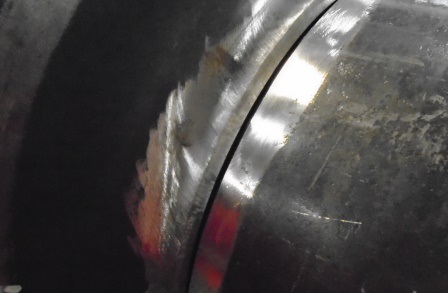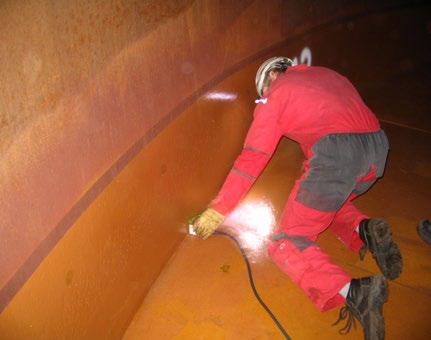
Recognizing the Relevance of Rigorous Storage Tank Welding Inspection Processes in Stopping Failures and Enhancing Life-span
In the world of commercial operations, the value of rigorous storage tank welding inspection procedures can not be overemphasized. These examinations function as an essential line of protection against prospective failures that could not just endanger asset honesty but likewise posture severe security dangers. By implementing different assessment approaches, companies can identify imperfections early, consequently staying clear of pricey consequences and expanding the life of their tank. Nonetheless, the landscape of compliance and ideal practices is ever-evolving, motivating a more detailed examination of how these processes can be maximized for optimum efficiency. What are the emerging fads and difficulties that professionals must browse?
Importance of Welding Evaluations
Identifying the crucial duty of welding assessments in keeping architectural honesty, these procedures ensure that welds meet well established standards and requirements - Tank Welding Inspection. Efficient welding examinations are extremely important in the building and construction and upkeep of tanks, as they straight affect the durability and security of the frameworks. By recognizing prospective deficiencies, such as inappropriate methods or material issues, inspections minimize the threat of catastrophic failures
Welding inspections include numerous methodologies, consisting of visual examinations, non-destructive screening (NDT), and evaluations of welding treatments. Each approach offers to validate the top quality and compliance of welds with sector guidelines, thus protecting both employees and ecological rate of interests. Regular assessments foster a culture of responsibility and quality within the workforce, guaranteeing that all group members stick to best practices.
Furthermore, these examinations contribute to the general lifecycle management of storage tanks by identifying wear or degradation early while doing so. By addressing these issues proactively, organizations can prolong the operational lifespan of their assets, ultimately causing set you back savings and boosted reliability. In summary, the value of welding assessments can not be overemphasized; they are crucial for guaranteeing security, longevity, and compliance in storage tank building and upkeep.
Typical Causes of Storage Tank Failings
Recognizing the typical reasons for tank failures is vital for stopping tragic events and making certain the durability of storage systems. One prevalent root cause of container failing is corrosion, which can considerably compromise the structural stability of storage tanks over time. Ecological aspects, such as direct exposure to moisture, chemicals, and temperature variations, can increase this process.
One more crucial aspect is incorrect welding strategies, which may cause flaws like fractures or incomplete joints. These concerns can jeopardize the tank's toughness and bring about leaks or tears. In addition, inadequate maintenance practices can cause undiscovered deterioration, inevitably increasing the risk of failure.
Style flaws, including poor thickness or inadequate material choice, can additionally add to container vulnerabilities. Operational variables, such as overfilling or exposure to severe stress, can stress the storage tank past its desired limits.
Key Evaluation Methods
Reliable assessment strategies play a vital role in minimizing the dangers connected with storage tank failures. A detailed method to container welding inspection includes a number of key strategies, each developed to determine possible defects and guarantee structural stability.
Visual inspection remains the initial line of protection, allowing examiners to recognize surface area anomalies such as cracks, deterioration, or imbalance. This technique is often supplemented by non-destructive testing (NDT) continue reading this methods, which are vital for assessing weld high quality without jeopardizing the container's integrity.

Additionally, magnetic particle testing (MPT) and dye penetrant testing (DPT) are effective for detecting surface flaws in ferromagnetic materials and non-porous surfaces, specifically. Each method has its staminas and limitations; for that reason, a combination of approaches is usually utilized to accomplish comprehensive inspection results.
Benefits of Extensive Assessments
While the immediate prices of extensive assessments might appear complicated, the lasting benefits dramatically exceed these first financial investments. Executing comprehensive inspection processes not only boosts the integrity and security of tank structures yet also reduces the threat of catastrophic failings that can cause considerable financial losses and environmental damage.
Rigorous inspections assist determine prospective issues early in the welding procedure, enabling for timely corrective activities that avoid pricey repair services or replacements down the line. This proactive method cultivates a culture of quality assurance, where adherence to finest practices comes to be ingrained in operational treatments. Furthermore, normal evaluations add to enhanced asset durability, as they ensure that containers continue to be in ideal condition throughout their lifespan.
Additionally, the documentation generated from these assessments functions as a valuable source for upkeep planning and efficiency analyses. This data-driven approach can also improve functional effectiveness, resulting in decreased downtime and enhanced productivity. Ultimately, extensive inspections not just secure the architectural honesty of containers however also give significant economic advantages, reinforcing the idea that spending in quality guarantee is a smart decision for any organization associated with storage tank operations.
Governing Standards and Compliance
Governing criteria and conformity are necessary parts of storage tank welding assessment processes, as they establish the framework for making sure safety and quality in operations. Conformity with these standards not just minimizes dangers however likewise improves the overall integrity of bonded frameworks. Different organizations, consisting of the American Culture of Mechanical Engineers (ASME) and the American Petroleum Institute (API), give standards that dictate appropriate techniques for welding, examination, and testing.
These criteria mandate using qualified workers, the execution Related Site of strenuous inspection protocols, and adherence to specific welding treatments. By lining up with regulatory requirements, organizations can make certain that their storage tanks fulfill the necessary safety and performance requirements, thereby lowering the chance of disastrous failings that can result in substantial financial losses and ecological damage.

In addition, regulative compliance fosters a culture of accountability and constant enhancement within the welding and fabrication sectors (Tank Welding Inspection). Normal audits and evaluations make certain that techniques stay straightened with evolving requirements, thus advertising long-lasting integrity and operational efficiency. Eventually, adherence to regulative criteria not only shields properties yet additionally improves the life-span of bonded tanks, guaranteeing they offer their intended objective efficiently in time
Final Thought
To conclude, extensive container welding examination processes play an important function in avoiding failings and extending the life expectancy of storage YOURURL.com frameworks. By identifying possible shortages through various inspection methods, companies can mitigate dangers related to tank honesty. The execution of these examinations cultivates a culture of quality control, leading to enhanced possession longevity, minimized upkeep prices, and enhanced functional performance. Following governing standards even more emphasizes the relevance of these inspections in keeping security and dependability within the industry.